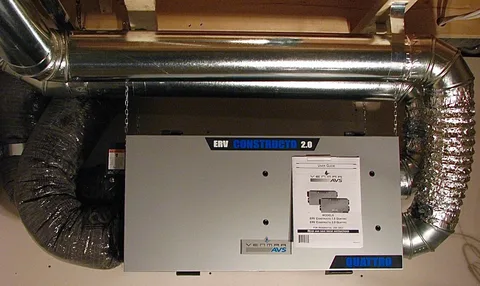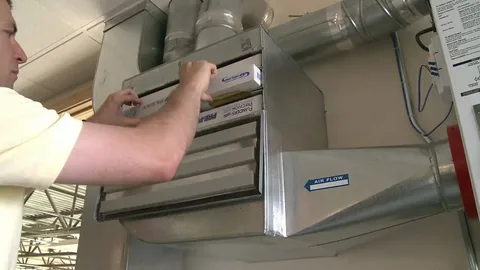Indoor air quality is often an overlooked aspect of our daily lives, yet it can profoundly impact our health, comfort, and overall well-being. Modern homes and buildings are designed to be energy-efficient, but this often comes at the cost of ventilation, leading to stale, polluted air that can exacerbate respiratory issues, headaches, and fatigue. Fortunately, there is a solution that can revolutionize the way we breathe indoors: heat recovery ventilation (HRV). By revitalizing indoor air, the HRV system can significantly reduce the risk of indoor air pollution, improve indoor air quality, and even reduce energy consumption.
What is HRV Heating System
An HRV (Heat Recovery Ventilation) heating system integrates the principles of ventilation with heat recovery to efficiently manage indoor climate control. Unlike traditional ventilation systems that exchange air, HRV heating systems recover heat from outgoing stale air and precondition the incoming fresh air.
This process ensures that while indoor air is constantly refreshed, energy used for heating or cooling is conserved. HRV heating is especially effective in cold climates where winters necessitate heating, and indoor air quality can suffer from being tightly sealed against outdoor conditions. By maintaining a balanced indoor environment with reduced energy consumption, these heating systems enhance comfort and contribute to sustainability goals by minimizing carbon footprints associated with building operations.
The benefits of HRV heating are significant. They improve indoor air quality by reducing pollutants, allergens, and moisture buildup, which can contribute to a healthier and more comfortable living or working environment. Additionally, these systems help lower energy bills by recovering and reusing heat that would otherwise be lost during ventilation. This energy-efficient approach reduces carbon emissions and aligns with sustainable building practices.
The Role of Air Recovery System
ARS systems typically include a heat exchanger or enthalpy wheel, which transfers heat and sometimes humidity between the outgoing and incoming air streams. During colder months, the heat exchanger warms the incoming fresh air using the heat from the exhaust air, reducing the need for additional heating. Conversely, in warmer months, the air recovery system can transfer coolness and dehumidify incoming air, easing the load on air conditioning systems.
Beyond energy efficiency, ARS systems significantly enhance indoor air quality by continuously removing pollutants, allergens, and excess moisture. It helps prevent the buildup of harmful substances and maintains a healthier indoor environment, which is crucial for occupant well-being and productivity.
The Benefits of HRV for Indoor Air Quality
As we spend more and more time indoors, the air quality we breathe has become a growing concern. The air inside our homes, offices, and public spaces can be a breeding ground for pollutants, allergens, and even toxins. Heat Recovery Ventilation (HRV) systems offer a revolutionary solution to revitalize indoor air quality.
These systems exchange stale indoor air with fresh outdoor air while recovering heat energy from the exhaust air. It means the power that would otherwise be wasted is reused to warm or cool the incoming fresh air, significantly reducing energy consumption. However, the benefits of HRV extend far beyond energy efficiency. By constantly introducing fresh air into the indoor space, these systems help eliminate pollutants, odours, and allergens, creating a healthier and more comfortable indoor environment.
Moreover, these systems can also help to reduce the risk of mould growth, mildew, and condensation, which can be particularly problematic in humid climates. By removing stale air and introducing fresh air, these systems help maintain a healthy indoor air balance, which is essential for maintaining good physical and mental health. With HRV, you can breathe easily, knowing you enjoy a healthier, more sustainable indoor environment.
The Science behind Heat Recovery
The science behind heat recovery ventilation is a fascinating concept extensively studied and refined over the years. At its core, heat recovery ventilation is a process that harnesses the thermal energy contained in the air we exhale and the air we bring into our homes. Doing so can recover a significant amount of heat that would otherwise be wasted and redirect it to warm or cool our living spaces.
The principle is simple: when we breathe, our warm, stale air is replaced by the fresh, cool air from outside. But what happens to the heat that’s released during this process? Traditionally, this heat is lost, and our homes feel cold and drafty. Heat recovery ventilation, on the other hand, captures this heat and uses it to warm our homes, reducing the need for traditional heating systems and the energy consumption that comes with them.
Through the use of sophisticated heat exchangers, heat recovery ventilation systems can recover up to 90% of the heat that would otherwise be lost. This can significantly impact our energy consumption and carbon footprint. By optimizing the heat transfer process, we can reduce the amount of energy needed to heat our homes, making our living spaces more comfortable, sustainable, and environmentally friendly.
 The Benefits of Heat Recirculation System
The Benefits of Heat Recirculation System
A Heat Recirculation System (HRS) is a specialized HVAC (Heating, Ventilation, and Air Conditioning) system designed to improve building energy efficiency and comfort by recirculating heat within the building rather than venting it outside. This system works by capturing and redistributing excess heat generated in various areas of a building, such as from equipment, lights, or occupants, and using it to warm cooler areas.
One common application of a heat-recirculation system is in commercial buildings, where large open spaces or multiple floors can lead to temperature variations. Instead of relying solely on centralized heating sources, an HRS can utilize heat recovery units strategically placed throughout the building to capture excess heat. These units then transfer the heat to areas where needed, reducing the overall demand on the primary heating system and improving energy efficiency.
Recirculation systems can be integrated into home heating systems in residential settings to optimize comfort and reduce energy consumption. For instance, in a multi-story house, heat generated from the lower floors can be recirculated to the upper floors during colder seasons, evening out temperature differences and reducing heating costs.
The Future of Indoor Air Quality and HRV
As we continue to navigate the complexities of modern living, it’s clear that the importance of indoor air quality will only grow. The future of indoor air quality is not just about eliminating pollutants but also about creating a healthy, sustainable, and comfortable living space. Heat Recovery Ventilation (HRV) systems are poised to play a crucial role in this endeavour, offering a versatile and efficient solution for maintaining optimal indoor air quality.
Imagine a world where buildings are not only thermally efficient but also breathe fresh, clean air. A world where indoor air quality is no longer a concern but a given. With these systems, this vision is no longer just a pipe dream but a reality within our grasp. As technology continues to advance and the demand for sustainable living solutions grows, these systems will be at the forefront of the indoor air quality revolution.
In the future, these systems will not only recover heat from exhaust air but also integrate with other building systems to create a seamless, high-performance indoor air quality solution. They will be designed to work in harmony with renewable energy sources, such as solar and wind power, to create a truly sustainable and self-sufficient building ecosystem. The future of indoor air quality is bright, and HRV is poised to lead the way.
Heating and Ventilation System
Heating and ventilation systems (HVAC) are integral to building infrastructure and crucial for year-round maintaining comfortable and healthy indoor environments. These systems serve dual purposes: heating during colder months and ventilating throughout the year to ensure fresh air circulation. In colder climates, heating systems typically use furnaces, boilers, or heat pumps to generate warmth, distributing it through ducts or radiant systems to maintain desired indoor temperatures.
Ventilation, on the other hand, involves exchanging indoor air with outdoor air to remove pollutants, control humidity levels, and replenish oxygen. Modern HVAC systems often integrate technologies like heat recovery ventilation (HRV) or energy recovery ventilation (ERV) to maximize efficiency by pre-conditioning incoming air with the heat or coolness from exhaust air.
Beyond comfort, these ventilation systems are crucial in building energy efficiency and sustainability. Energy-efficient HVAC designs reduce operational costs and minimize environmental impact by optimizing energy use. Smart controls and sensors further enhance efficiency by adjusting heating and ventilation based on occupancy and outdoor conditions, ensuring optimal performance while conserving energy. Additionally, advanced filtration systems can improve indoor air quality by capturing airborne particles and allergens, promoting healthier indoor environments for occupants.
Additional Tips for Improving Indoor Air Quality
As you’ve learned about the benefits of heat recovery ventilation, you may wonder how to take your indoor air quality experience to the next level. Fortunately, you can follow several additional tips to ensure your indoor air is fresh, healthy, and free from pollutants. For instance, regular cleaning and maintenance of your HRV is crucial to prevent the buildup of dust and debris that can compromise its performance. Additionally, incorporating air purifiers and HEPA filters into your home can help eliminate airborne particles and allergens, making breathing easier and reducing the risk of respiratory issues.
Another important aspect to consider is the importance of proper ventilation in areas prone to moisture, such as bathrooms and kitchens. Installing exhaust fans and ensuring adequate drainage can help prevent moisture buildup, which can lead to mould and mildew growth. Furthermore, incorporating plants into your home decor can also positively impact indoor air quality, as they naturally purify the air and release oxygen.
By combining these additional tips with the benefits of heat recovery ventilation, you can create a healthier and more comfortable living or working space. Prioritizing indoor air quality can reduce the risk of health issues, improve your overall well-being, and enjoy a more pleasant living environment.
Conclusion
In conclusion, an HRV system is an indispensable component of modern building design, enhancing indoor air quality, comfort, and energy efficiency. By continuously exchanging stale indoor air with fresh outdoor air while recovering the heat (or coolness) from the outgoing air, these systems help maintain a balanced indoor environment throughout the year. This process reduces the buildup of pollutants and allergens and minimizes the energy required for heating or cooling, resulting in significant cost savings and environmental benefits.
FAQS
What Is An HRV System?
It is a ventilation system that exchanges stale indoor air with fresh outdoor air while recovering the heat (or coolness) from the outgoing air. It helps maintain indoor air quality and temperature control efficiently.
How Does A Heat Recovery System Work?
Heat recovery systems transfer heat from a high-temperature source to a lower-temperature sink. It is typically achieved through heat exchangers or heat pumps, which extract heat from the exhaust air or liquid and use it to preheat incoming air or water.
Are Heat Recovery Systems Suitable For All Climates?
Yes, heat recovery systems can be adapted to various climates and applications. They are particularly effective in climates with large temperature differentials between seasons, where they can capture and reuse heat efficiently.
| Other Good Articles to Read |
| Niche Blogs Connect |
| Blogs 97 |
| Blog Stitution |
| Blogs Cotch Rouge |
| Blog Signatr |
| Blog Sintonias |
| Blog Zilla |
| Consumer Forums |
| Finance Forums |
| G Blogs |
| Too Blog |
| Related Business Listings |
| Contact Directory |
| Local Business Profiles |

